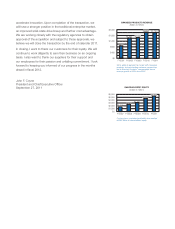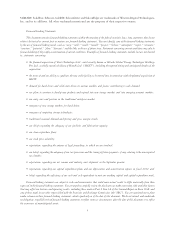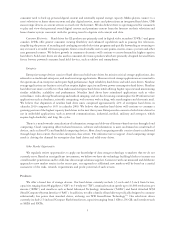Western Digital 2011 Annual Report Download - page 14
Download and view the complete annual report
Please find page 14 of the 2011 Western Digital annual report below. You can navigate through the pages in the report by either clicking on the pages listed below, or by using the keyword search tool below to find specific information within the annual report.The drive interface receives instructions from the host computer, while the controller directs the flow of data to or from
the disks and controls the heads. The location of data on each disk is logically maintained in concentric tracks divided into
sectors. The host computer sends instructions to the controller to read data from or write data to the disks, based on
logical track and sector locations. Guided by instructions from the controller, the HSA pivots in an arc across the disk
until it reaches the selected track of a disk, where the data is recorded or retrieved.
The storage capacity of a hard drive is determined by the number of disks and each disk’s areal density (track density
multiplied by bit density), which is a measure of the amount of data that can be stored on the recording surface of the disk per
unit area. Head and magnetic media technologies are two of the key components affecting areal density. As areal density
increases, achieving a given drive capacity potentially reduces product costs over time through reduced component
requirements. We are vertically integrated in these two most important technology components of hard drives (heads
and magnetic media). We also invest considerable resources in research and development, manufacturing infrastructure and
capital equipment of head and magnetic media components, in order to secure our competitive position and cost structure.
Solid-state drives use semiconductor, non-volatile media, rather than magnetic media and magnetic heads, to store
and allow fast access to data without any moving parts. The capacity of a solid-state drive is based on the total number of
megabytes (“MB”) or GB of semiconductor media in the solid-state drive.
Our products generally leverage a common platform for various products within product families, and in some cases
across product families, resulting in the commonality of components which reduces our exposure to changes in demand,
facilitates inventory management and allows us to achieve lower costs through purchasing economies. This platform
strategy also enables our customers to leverage their qualification efforts onto successive product models. For a discussion
of risks related to technological innovations, see Item 1A of this Annual Report on Form 10-K.
Sales and Distribution
We maintain sales offices in selected parts of the world including the major geographies of the Americas, Asia
Pacific, Europe and the Middle East. Our international sales, which include sales to foreign subsidiaries of United States
(“U.S.”) companies but do not include sales to U.S. subsidiaries of foreign companies, represented 83%, 81% and 80% of
our net revenue for 2011, 2010 and 2009, respectively. Sales to international customers may be subject to certain risks not
normally encountered in domestic operations, including exposure to tariffs and various trade regulations. For a discussion
regarding the risks related to sales to international customers, see Item 1A of this Annual Report on Form 10-K.
We perform our marketing and advertising functions internally and through outside firms utilizing both consumer
media and trade publications targeting various reseller and end-user categories. We also maintain customer relationships
through direct communication and providing information and support through our Web site. In accordance with
standard hard drive industry practice, we provide distributors and retailers with limited price protection and programs
under which we reimburse certain marketing expenditures. We also provide distributors, resellers and OEMs with other
sales incentive programs.
Original Equipment Manufacturers. OEMs purchase our products, either directly or through a contract manufacturer such
as an original design manufacturer (“ODM”), and assemble them into the devices they build. OEMs typically seek to qualify
two or more providers for each generation of products and generally will purchase products from those vendors for the life of
that product. Many of our OEM customers utilize just-in-time inventory management processes or supply chain business
models that allow for “build-to-order,” in which they do not build until there is a firm order. For certain OEMs, we maintain a
base stock of finished goods inventory in facilities located near or adjacent to the OEM’s operations. We believe that our success
depends on our ability to maintain and improve our strong relationships with the leading OEMs.
Distributors. We use a broad group of distributors to sell our products to non-direct customers such as small
computer and CE manufacturers, dealers, systems integrators, online retailers and other resellers. Distributors generally
enter into non-exclusive agreements with us for the purchase and redistribution of our products in specific territories.
Retailers. We sell our branded products directly to a select group of major retailers such as computer superstores,
warehouse clubs, online retailers, and computer electronics stores, and authorize sales through distributors to smaller
retailers. The retail channel complements our other sales channels while helping to build brand awareness for WD and
our products. We also sell our branded products through our Web site.
8
























